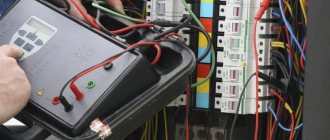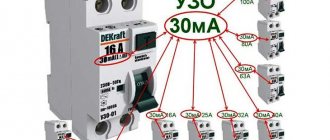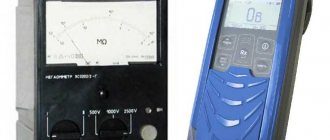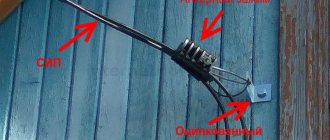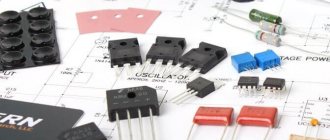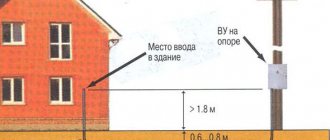Leakage current is an electric current flowing into the ground, open, third-party conductive parts and protective conductors under normal conditions (definition according to GOST 30331.1-2013 [1]).
Having carried out a very extensive analysis of existing regulatory documentation, Kharechko Yu.V. in his book [2] concludes the following:
“From the definition presented above, it follows that leakage current occurs under normal operating conditions, when the insulation of live parts of a low-voltage electrical installation that are energized is not damaged. Such conditions are called normal conditions. Leakage current flows from live parts into the ground or third-party conductive parts. It should be taken into account that the leakage current of class I electrical equipment usually flows along the following conductive path: from live parts to its open conductive parts and then to the protective conductors connected to them. »
Kharechko Yu.V. also explains the reason for the occurrence of leakage current [2]:
“The active insulation resistance of current-carrying parts of electrical equipment cannot be infinitely large, and their capacitance relative to the ground or conductive parts connected to the ground cannot be equal to zero. Therefore, a small electric current constantly flows from any live part that is energized into the ground, as well as into the conductive parts electrically connected by protective conductors to the grounding device of the electrical installation of the building and to the grounded current-carrying part of the power source, which is called leakage current in regulatory documentation. That is, under normal conditions, there is always an electric current leakage into the ground, open and third-party conductive parts and protective conductors from the live parts of operating electrical equipment. »
There is only one way to eliminate leakage currents - by disconnecting the electrical installation of the building.
How to independently check current leakage using a household multimeter or an indicator screwdriver
Professional electricians quite often encounter current leakage when inspecting electrical wiring, especially old wiring, electrical appliances of poor quality and other electrical equipment. The problem of leakage current is also quite common in the operation of cars and causes rapid discharge of the battery. This article will discuss actions to identify electricity leaks in relation to a 220V home network, but there are no fundamental differences between it and a car electrical network.
The reasons for current leakage are quite commonplace; over time, the protective insulation of the wire wears out and its characteristics change. If the wiring is used incorrectly, kinks, cracks, and abrasions appear on the wire insulation. The main task of insulating wiring and conductive elements is to protect people from electric shock and prevent leakage of electricity.
Even new electrical appliances and wiring have small current leaks. Almost any insulation is not ideal, especially for cheap cables in the low price category. Cheap electrical wiring, as a rule, has microcracks from the factory, it is less resistant to temperature and humidity changes, and small thickness defects are often found. Improper operation, overheating of the wire at loads exceeding the design ones - all this damages the insulation and leads to current leaks.
Current leakage can be determined by the following characteristic signs: touching the body of an electrical appliance, a wall, or a pipeline causes a slight tingling sensation in the fingertips. But be careful - a leakage value not exceeding 10 mA is considered safe, but a leakage current of more than 30 mA is deadly.
If you suspect a current leak, you must immediately turn off the power to the room and call professionals. A car with significant leaks is also unsafe to operate. The second sign of current leakage is increased consumption disproportionate to use and, as a result, large electricity bills or discharge of the battery in the car.
What devices can detect electricity leaks?
Electrical laboratory specialists use a professional device for measuring insulation resistance - a megohmmeter. Such devices are quite expensive and are not used in everyday life.
In many homes or garages, you can find a household multimeter and an indicator screwdriver, and with them you can independently locate the location of a current leak or an electrical appliance with defective insulation.
In order to check the insulation resistance of an electrical appliance using a “household multimeter”, it is necessary to completely disconnect the device being tested from the power supply. On the multimeter, set the regulator to the 20 MΩ position. Touch the pin of the plug with one probe, and the metal part of the electrical appliance with the other, it is better to sequentially in several places. If the number “1” is displayed on the display, then there is no leakage current, the insulation is working properly, indicators on the screen below one indicate leakage currents and the lower the indicator, the greater the leakage current.
If you do not have a multimeter, then you can detect a leak with a regular, even the cheapest indicator screwdriver. Modern indicators are sensitive even to small currents. The algorithm of actions is even simpler; you need to plug in the device and touch the tip of the screwdriver to the metal parts of the device, pipeline or walls in several places. It is better to pre-shade the room; if there is a leakage current, the indicator will light up with varying degrees of intensity.
How to find a leak in electrical wiring or cable
It is impossible to find an insulation defect in hidden wiring without special equipment. In this case, it is necessary to call specialists from an electrical engineering laboratory. When open, you can visually carefully inspect the wire for damage to the insulation, especially in places where the cable comes into contact with walls, risers, and metal parts.
Simple ways to find leaks
A routine visual inspection may give unexpected results. All kinds of chafing and destruction of insulation on wires are not difficult to find.
You need to inspect not only the external wires; if possible, check the contact blocks and wiring harnesses inside the electric stove, washing machine or boiler.
Then you need to narrow your search area. This can be done if you have a competently laid out input panel: machines and RCDs are divided into consumption groups and premises. By sequentially disconnecting one or another group, you will be able to understand on which line the faulty electrical appliance is connected.
After determining the connection line, disconnect potentially dangerous electrical installations from the network one by one and observe the behavior of the RCD.
If this does not produce results, we will use available technical means. To understand how to find a current leak, you do not need to have a specialized education. All processes are described in the school physics course. When you are not confident in your basic knowledge of electrical engineering, it is better to use the services of professional electricians.
- An indicator screwdriver is an almost ideal (although not accurate from a measurement point of view) search device. The principle of its operation is precisely based on the operation of leakage currents. It is enough to find a piece of metal without paint and touch it with a measuring contact. The surface of plumbing fixtures can become an ideal conductor of electricity from a boiler or washing machine.
It is necessary to turn on all electrical appliances in operating mode and go through a pre-drawn plan (so as not to forget anything), touching all potentially problem areas. - Household multimeter (with a measurement range in tens of megohms). The calculation here is simple: according to the PUE (Electrical Installation Rules), insulation resistance ensures safety at a value of more than 20 MOhm.
Important: This standard corresponds to supply voltages up to 1000 V.
If the resistance is less than the set value, leakage and potential breakdown to the housing is possible.
How to correctly measure the insulation resistance in an electrical installation?
- disconnect the electrical appliance from the power supply;
- we set the operating mode of the measuring device to the MOhm position, the range is tens of units;
- securely fasten one measuring probe to the contacts of the power plug (one at a time);
- We apply the second probe to the unpainted parts of the body of the electrical appliance.
Important: During measurement, do not touch the contacts and exposed parts of the housing with your hands. Otherwise, distortions can be introduced into the measured value.
Finding the cause of current leakage
There are several reasons for current leakage in a car. These may be regular problems with the factory equipment that was installed during the construction of the car. These include:
- wiring;
- audio system;
- generator;
- alarm;
- starter.
But standard leaks appear less frequently and mainly due to the high mileage of the vehicle.
Non-standard devices include those devices that the driver additionally installed on the car. For example, this could be a video recorder, a navigator, an alarm system and a non-factory radio, as well as cameras and radar detectors.
Therefore, when the test readings are above 80 mA, it is important to find a current leak. First of all, you need to check the following points:
- Determine which battery is worth. If it is old, then current leakage is normal for a worn-out device.
- Check that the headlights, dimensions and car radio are turned off.
- Look at the wiring insulation, it may be the cause.
- Possible heavy dust on the contact terminal blocks or on the sockets to which devices in the car are connected. Due to the large layer of dust, they could oxidize.
- Negligence in installing additional devices, which led to a short circuit.
- Metal fasteners damaged the wiring.
- Melted wires that are close to the motor.
If all these points have been checked and no problems are found, then the problem may be the formation of salt deposits on the circuit with a thick starter wire as a result of water accumulation. This problem is also possible with the generator wiring. The battery itself also gets dirty on top.
On a note!
If there are problems with the insulating layer of the electrical wiring, spontaneous combustion is possible!
If the problem cannot be detected, it is recommended to conduct a full diagnosis of the generator. To do this, you need to measure the voltage on the battery. This is done as follows:
- turn off the engine;
- two terminals from the battery are removed;
- connect the multimeter: the black probe of the device is negative, and the red probe is positive;
- with a charged battery, the value should be 12.5–12.9 V.
After the procedure, the terminals are returned to their place and the engine is turned on. After this, we turn on the heated glass, climate control and side lights. This is necessary to load the generator. Reconnect the multimeter to the battery. The reading should be between 13 and 13.3 V. A maximum reading of 14.3 V is possible.
If the indicator does not exceed 13.8 V, then most likely the cause of the leak is in the generator. Then it’s best to go to a service center and do a full diagnosis. If the indicators correspond to the required range, then the cause of the leak is in the network itself.
Current leakage and ways to eliminate it
Since our main audience is readers with little knowledge in the field of electrical engineering, we will limit ourselves to a general description of this phenomenon. The current leakage we are considering today is, at its core, the unwanted flow of electricity along a path that was not intended for it. Most often, movement occurs along pipes, appliance housings, damp plaster and other structural elements in the house.
The causes can be many factors, but in practice, favorable conditions for leakage occur when the insulating layer is damaged. The destruction of its integrity occurs as a result of thermal processes, gradual aging, and mechanical stress. Prolonged exposure of conductors under overload can provoke undesirable moments. We will try to understand all this in more detail in today’s article.
Current testing
To begin with, we determine what kind of current flows in the circuit - alternating or direct. The choice of the socket for the black probe, from the “10 A” or “VΩmA” options, is made after specifying the approximate parameters in Amperes. The procedure is largely identical to the one discussed above. If, after connecting to the connector with the maximum current value, the display shows a significantly lower value, place the plug in another socket. When re-displaying smaller parameters, we stop at the range with a lower amperage.
It is important to remember that the connection of the device in the circuit in this case is also carried out exclusively in parallel
Features of wiring testing
The main potential threat from a leak in hidden wiring is damage during wallpapering or applying plaster. There are ways to detect defects without turning to professionals. One of the long-proven and popular options is a conventional transistor receiver with a reception range of long and medium waves.
At the beginning of the upcoming event, make sure that all energy consumers are turned off. We tune the receiver to a frequency free from broadcasting and slowly move with it along the cable laying areas in the walls. In the immediate vicinity of places with leaks, a specific manifestation in the dynamics of background noise is observed.
ABS sensor
It is checked by two parameters: voltage and resistance.
To start measuring, select the appropriate mode on the multimeter. If you want to know the resistance value, for most the norm is 1.2-1.8 kOhm. Connect the device to the sensor and start taking measurements. At the same time, shake the wires going to the element. If the numbers on the screen change and become higher or lower than normal, there is a problem with the sensor.
Measuring voltage is a little more difficult - this can only be done with a jack or in a car service on a stand. You need to spin the car wheel to 40-50 rpm and monitor the multimeter readings. On any machine it should output 2 volts.
Voltage measurements
For a network with alternating voltage, the switch arrow is set to ACV. Probes are connected to the COM and “VΩmA” connectors. If you are unsure of the approximate range of the voltage being tested, select the maximum value. When a value less than the set value appears on the display, the switch is switched to a lower voltage level. Using the selection method, you can quickly determine the approximate value of the desired value. For a constant voltage network, this process is carried out in a similar way. Most often, in the second option, the 20 V mark is selected. An example would be repair work on the electrical equipment of a car.
It is safe to say that such an event does not cause any major difficulties. You just need to adhere to basic safety measures - avoid touching the bare areas of the probes with your hands.
Self-diagnosis with a multimeter
Diagnostics is carried out using a conventional multimeter (tester). Current measurements are carried out in a mass discontinuity or in a “positive” section discontinuity. The mass discontinuity detection scheme is considered safe. To do this you need to do the following:
- The multimeter settings correspond to measuring current readings in amperes (10-20 A);
- Disconnect the negative terminal from the battery;
- Connect one wire of the tester to the battery terminal;
- The other wire of the tester should be on the removed wire.
The polarity may not be observed for the electronic tester. Before starting measurements, turn off the ignition and remove the key.
Detecting a leak in the positive gap involves the following scheme:
- Set the amperes on the device;
- Disconnect “+” from the battery;
- Connect the negative connector of the tester to the disconnected battery terminal;
- Connect the positive connector of the tester to the “-” battery.
If the steps are completed correctly, a current value will appear on the tester screen. Exceeding the norm (15–80 mA) by the found current value indicates a leak. As a result, you need to look for the problematic circuit.
What is the danger of such a phenomenon
Some current losses occur even if the insulation is completely intact. In this case, insignificant leakage values practically do not affect the operation of the equipment and are not dangerous to humans. But serious problems arise when the insulating layer is partially or completely destroyed.
Any contact with the body of the device when the insulation resistance is lost, including touching a simple socket and plug, heating pipe or water supply, even to a wall or partition in the house, is fraught with the passage of leakage currents into the ground through the body. Severe injuries and deaths from such incidents are common.
How to check current leakage in a car with a multimeter
When the first signs of such a malfunction appear, it is necessary to check the current leakage in the car using a device.
Check sequence:
1. Before performing work, you need to find a diagram of the location of the car's fuses. This can be done by downloading the car's operating manual and asking the appropriate request in a search engine. In some cars, the fuse code is located on the fuse box cover. You need to find all the places where there are fuses in the car.
2. The positive terminal of the battery is removed. The ignition and all electrical equipment of the car must be turned off. Some experts recommend monitoring via the negative terminal. There are no fundamental differences, the circuit is still the same. When monitoring using the positive terminal, it is easier to search for a specific leak location.
3. The multimeter switches to the 10 Ampere DC measurement mode, the probes are installed in the appropriate connectors. It is better to put crocodile tips on the probes.
4. Next, the positive (red) probe is carefully secured to the positive terminal of the battery, the negative one - to the removed terminal going to the vehicle equipment. The location of this connection must be protected from accidental contact with the car body (you can simply temporarily insulate it with a rag) so that there is no short circuit.
5. The digital display of the multimeter will indicate the leakage current. If its value is less than 0.2 Ampere, no further control can be performed. If the current is more than 0.5 Ampere, that is, the critical value, it is necessary to proceed to further operations.
In the case when its value is in the range from 0.2 to 0.5 Ampere, the decision on the advisability of further actions is made independently. If the current exceeds the upper measurement limit (as shown in the following photo), you should stop measuring immediately and call a specialist.
6. If the leakage current in the car is greater than the critical value, begin to search for the specific cause and its source.
An assistant is needed for this. He will sequentially remove and insert fuses into their original places. At this time, the “operator” of the multimeter must monitor changes in the device readings.
If, with the fuse removed, the readings do not change significantly (by more than 5%), it means that practically no leakage current flows through this fuse.
It is more correct to start turning off - turning on with powerful fuses designed for high currents. This can speed up the search process. Usually along a chain of large rated fuses there are several smaller fuses.
If, for example, when dismantling the fuse responsible for the body control unit, the leakage current has decreased significantly, it is necessary to move on to monitoring small fuses responsible for lighting equipment, wipers, washer and other elements of body equipment.
Video - finding a current leak in a car:
It is best to go through all the fuses using this method. Car alarm fuses are usually not installed in standard places; they can “hang” next to the main alarm unit.
Some auto electricians use a sophisticated testing method. It does not require an assistant.
7. Complicated method. In this case, the positive terminal of the battery is connected back. The fuses are pulled out sequentially. The multimeter probes are installed in the connectors of the removed fuse, monitoring the current in a specific circuit. This method is more labor-intensive, but accurate.
8. Having deciphered all the circuits through which current flows from the fuse layout diagram, proceed to establish the specific cause of the leak in these circuits. To do this, you need experience working with car electrical circuits. The most common reasons:
- wiring short;
- relay sticking;
- failure of electronic components.
9. To temporarily eliminate the problem of current leakage, you can not replace the fuse through which the leakage occurs. For example, if the cause of the leak is a malfunction of the car radio, you can turn off the corresponding fuse while parked.
Leakage current path
Kharechko Yu.V. in his book [2] describes the paths of leakage current flow as follows:
“The path along which leakage current flows depends on the type of grounding of the system. In electrical installations of buildings corresponding to the TT and IT grounding systems, leakage currents of class I electrical equipment flow through the intact basic insulation from live parts to their exposed conductive parts. Leakage currents flow into the ground from exposed conductive parts through protective conductors, main grounding busbars, grounding conductors and grounding conductors. »
“If the electrical installations of buildings comply with the grounding types of the TN-S, TN-C and TN-CS systems, then most of the leakage currents flow not into the ground, but through the protective conductor in the TN-S system and PEN conductors in the TN-C and TN systems -CS of low-voltage electrical distribution networks flow to grounded live parts of power supplies. In other words, leakage currents of class I electrical equipment flow along the same conductive paths along which protective conductor currents flow (see Fig. 1 and 2 of the article “Protective conductor current”). »
“Class 0, II and III electrical equipment leakage currents flow along less defined conductive paths, such as through the electrical equipment enclosure into the ground or third-party conductive parts. Moreover, part of the conductive path may be the body of a person who holds portable electrical equipment in his hands or is in electrical contact with accessible parts of mobile or stationary electrical equipment. Leakage currents can flow through floors, walls and other elements of the building if for some reason (for example, due to increased humidity) their resistance has sharply decreased, as well as through other undesirable conductive paths. »
Leakage currents always occur in electrical circuits during normal operation of a building's electrical installation (under normal conditions). Their values in final electrical circuits depend little on the type of system grounding and rarely exceed several tens of milliamps (usually no more than 10 mA). If electrical equipment with increased leakage currents is used in the electrical installation of a building, then additional electrical protective measures must be taken in accordance with the requirements, for example, subsection 707.4 of GOST R 50571.22-2000. In this case, the values of increased leakage currents are measured in tens of milliamps. This circumstance is directly indicated by the title of clause 707.471.3.3 of the national standard: “Additional requirements for information processing equipment with leakage current above 10 mA.”
How does it proceed
- Option one. The housing or frame of an electrical installation (refrigerator, system unit, washing machine, etc.) touches a metal conductor in contact with the ground. This could be a heating radiator, a damp concrete floor in an apartment, or another electrical installation connected to ground. At the point of contact, the circuit closes and the same leakage current occurs. What is the danger? Local heating of the contact point may cause a fire. If the contact is reliable, the current will increase to the threshold of the protection device (input circuit breaker on the power panel). With a weak touch, sparking and the same local heating will be observed. Most often, this leads to melting and further damage to the supply wires. In addition, this phenomenon provokes electromagnetic interference.
- Option two. The electrical installation housing does not have contact with grounded objects and is not itself grounded. When a person touches the external panels, a load occurs (the human body is a conductor), and an electric current flows through the body. Since the resistance in this case is high, the current strength is insufficient to trip the circuit breakers. But harm to health, even death, can be caused. It is unacceptable to rely on the user to wear shoes with rubber soles. It’s the same as thinking that a linoleum-covered floor protects you from electric shock. Moreover, when the washing machine is operating, the owner’s hands are most often wet, which reduces the resistance of the skin. And if in the first case a properly selected circuit breaker is sufficient, the second option requires more advanced measures. For example, the inclusion of an RCD in the power circuit, which reacts to a small leakage current rating, provokes the operation of a circuit breaker.
Important: Even if you are confident that electrical installations and current-carrying lines are in good condition, periodic checking of current leakage is mandatory in each room. How can you determine whether there is a problem or not? To measure the leakage current, they usually call a team of master electricians who search for problematic installations using the device
At industrial facilities, this procedure is mandatory, as well as when commissioning housing stock. At large enterprises in big cities, such as Moscow, there are even staff departments of specialists on this issue
How can you determine whether there is a problem or not? To measure the leakage current, they usually call a team of master electricians who search for problematic installations using the device. At industrial facilities, this procedure is mandatory, as well as when commissioning housing stock. At large enterprises in big cities, such as Moscow, there are even full-time departments of specialists on this issue.
How can you independently check the leakage current in an apartment or residential building? The sensation of tingling electric current when you touch the body of the washing machine with a wet hand is a dubious and dangerous diagnosis.
Means of protection
In order to guarantee the elimination of cases of electrical injuries in the house, it is necessary to equip the home electrical network with leakage protection devices, which are currently widely used as residual current devices (RCDs) and differential circuit breakers. We talked about how to choose an RCD based on current in a separate article.
An alternative option is to use a differential circuit breaker, which combines an RCD and a circuit breaker. The difavtomat will also help protect against unfavorable phenomena, because will instantly operate and de-energize the network when danger arises.
To learn more about why you need to use an RCD, watch the video:
So we looked at what current leakage is in an apartment and a house, what are the reasons for its occurrence, as well as protective measures at home. We hope the information was useful and interesting for you!
It will be useful to read:
How to find an energy consumer?
Further search for current leakage in the car is carried out using the fuse box (usually installed under the hood near the windshield). The procedure is as follows:
- Leave the ammeter connected to the battery terminals and remove the fuse box cover.
- Alternately pulling out the fuses from their sockets, monitor the readings on the multimeter display. If the manipulation does not produce results and the current value remains the same, insert the element back into the socket and move on to the next one.
- When you notice a drop in current to normal, find out which electrical appliances are “hanging” on the circuit of the pulled fuse. Look for the “culprit” using the method of elimination, checking each consumer separately.
It is not difficult to deal with the cigarette lighter and the light bulb - you need to turn off these devices and measure the current at the relay contacts that close the heater circuit. If the readings are higher than normal, disconnect the heating element connector and try replacing the relay. Several consumers are powered directly from the battery, bypassing the fuse box. This includes the electronic engine control unit, starter and generator. If manipulations with fuse links do not bring results and the display readings have not changed, proceed to checking the electric generator:
- Disconnect the positive battery terminal.
- Unscrew the power wire from the generator and wrap the exposed end with any dielectric (you can use a rag) to avoid a short circuit.
- Connect a multimeter to the battery open circuit and check the current value. If the diode bridge in the generator fails, consumption will drop to normal.
Typically, a broken alternator diode causes a large current draw, measured in amperes. The loaded winding acts as an electromagnet, which can be easily checked using a metal key attached to the unit pulley. If the key is pulled, the electric generator is probably faulty and is wasting battery power.
In a similar way, you can measure current leakage in other directly connected circuits. Look at the electrical diagram of the car and disconnect the wires one by one, bypassing the fuse box. If for various reasons the multimeter is missing, try to solve the problem in the following ways:
- carefully inspect the inside of the car for a burning light in the glove compartment or trunk;
- try with your hand the glass with built-in electric heaters;
- check if the seats are heating up;
- Turn off the burglar alarm and stereo amplifier completely.
When faced with current leakage and battery discharge, remember what non-standard equipment you happened to install on your car in recent days. The reason probably lies in the incorrect connection of the device.
How to determine if an electrical appliance is damaged?
The classic means of measuring insulation resistance is a megohmmeter, but since such a device is quite rare in household use, for this purpose you can use the simplest and most accessible measuring instruments, such as a voltage indicator and a multimeter.
Another option is to check for current leakage with a voltage indicator. This testing method can be used if the electrical device being tested has a metal shell. If there are doubts about the serviceability and safety of using the device, the presence or absence of a leak can be checked with an indicator screwdriver designed to search for a phase in the network. To do this, it is necessary, when the consumer is switched on, to touch the tip of the indicator screwdriver to the metal body of the electrical device; if even a slight activation of the phase detector indication occurs, the consumer being tested is faulty and poses a danger. We described in more detail how to use an indicator screwdriver in a separate article.
Current leakage into the housing in a device with a metal shell can be caused not only by loss of insulation resistance. The reason for this may be a break in the jumper grounding the metal body of the product, if a grounding system is provided.
Important! During the inspection, you must be careful and avoid touching the metal body of the product and the screwdriver tip with your hands. Check with a multimeter. Checking the insulation resistance with a multimeter is carried out only on de-energized equipment
Before checking, the measuring device must be switched to resistance measurement mode at 20 MΩ. Fix the multimeter probe on the body of the product being tested, the second on one of the contact pins of the plug. The same operation must be done for the second contact pin and with the polarity of the probes replaced. On working electrical equipment, infinity should appear on the scale of the measuring device. Otherwise, the electrical equipment cannot be used; it must either be sent in for repair or disposed of. We also reviewed the operating instructions for the multimeter on the website
Checking the insulation resistance with a multimeter is carried out only on de-energized equipment. Before checking, the measuring device must be switched to resistance measurement mode at 20 MΩ. Fix the multimeter probe on the body of the product being tested, the second on one of the contact pins of the plug. The same operation must be done for the second contact pin and with the polarity of the probes replaced. On working electrical equipment, infinity should appear on the scale of the measuring device. Otherwise, the electrical equipment cannot be used; it must either be sent in for repair or disposed of. We also reviewed the operating instructions for the multimeter on the website
Check with a multimeter. Checking the insulation resistance with a multimeter is carried out only on de-energized equipment. Before checking, the measuring device must be switched to resistance measurement mode at 20 MΩ. Fix the multimeter probe on the body of the product being tested, the second on one of the contact pins of the plug. The same operation must be done for the second contact pin and with the polarity of the probes replaced. On working electrical equipment, infinity should appear on the scale of the measuring device. Otherwise, the electrical equipment cannot be used; it must either be sent in for repair or disposed of. We also reviewed the operating instructions for the multimeter on the website.
Checking with a megger. The checking procedure is the same as in the case of a multimeter. When using a megger, you must remember that when you rotate its handle, a voltage of 500 to 1000 volts is generated at the output of this device, which can irreversibly damage low-current electronic elements of the equipment.
We talked about how to use a megaohmmeter in a separate article on the website!
Characteristic signs
Having an understanding of what an electrical leak is, its causes and the accompanying dangerous consequences, it doesn’t hurt the owner of a house or apartment to know how to identify electrical equipment with reduced insulation resistance. To begin with, you should firmly understand that if, when touching an electrical appliance, pipelines or walls in a room, even a subtle effect of electricity is felt, there is a current leak in the electrical network of a house or apartment. Loss of insulation resistance can occur both in faulty electrical consumers and in wiring. A common sign of a dangerous phenomenon is when there is an electric shock in the bathroom.
How to use a tester (multimeter) to check current leakage on a car
Using a multimeter is the only way to detect current loss and determine its magnitude.
First, measure the voltage on the battery to exclude its discharge or malfunction, and then:
Turn off the ignition, disconnect both terminals sequentially from the battery contacts
Be careful not to touch both terminals, the positive terminal and the housing at the same time. To measure current leakage, you need to set the multimeter to constant voltage measurement mode (V 100): connect the red probe of the device to the positive terminal, and the black probe to the negative terminal. Measure the leakage current in the car with a multimeter: read the readings from the display. The normal voltage on a new battery is 12.5-12.9 volts, on a previously used one - 12.0-12.8 volts. Disconnect the device from the battery, replace the terminals, start the engine, apply a small load, for example, turning on the side lights or heated windows. Repeat measurements in operating mode
Since the generator is now turned on, the voltage should increase to 13.0-13.5 volts, sometimes up to 14.2 volts.
If the voltage does not change or changes slightly when the generator is running, the part is most likely faulty. The service center will be able to finally “diagnose” the generator.
Well, if the voltage has increased, you can continue searching for current leakage. To do this, turn off the ignition again and, without removing the terminals, measure the voltage at the battery. Repeat the measurements every 1-2 hours during the day, if during this period the voltage drops by 0.2 volts or more, there are serious leaks in the circuit. There is another way that involves:
- disconnecting the negative terminal from the battery;
- setting the multimeter to current measurement mode (A 0.1 or mA 100);
- connecting the red probe of the multimeter to the negative terminal of the battery, and the black probe to ground (housing);
- reading readings.
How to find out if the insulation of a device is damaged
Although the best option is to use a magnetometer, it is rarely available in everyday life. Therefore, to check the device for breakdown and damage to the insulation, you can use a multimeter or other conventional tester to measure voltage.
You can also use a dot voltage indicator. This option is suitable if the electrical appliance has a metal case.
You can also use an indicator screwdriver to check a specific phase for current leakage. For this process, it will be enough to touch the phase with the indicator, and if it works, then the wire is really faulty.
On a note. If the device body is metal, the root cause is not always damage to the insulation. The problem may also be that the grounding contact is broken or broken.
During any work with an electrical appliance that may be faulty, it is extremely important to take all precautions and avoid contact of hands and body with the metal body and conductors of the electrical appliance, as well as with the measuring screwdriver.
To check a device with a multimeter, you first need to turn off the power to the network or device. Then set the multimeter to twenty megohms. Afterwards, fix one probe on the body of the device being tested, and the second on the plug pin.
If the multimeter detects a malfunction and displays the corresponding indicator on the display, the device being tested is prohibited from being used and must be returned for service or repair, or even completely disposed of.
Testing with a device - a megammeter - is carried out according to the same principle as with a multimeter.


